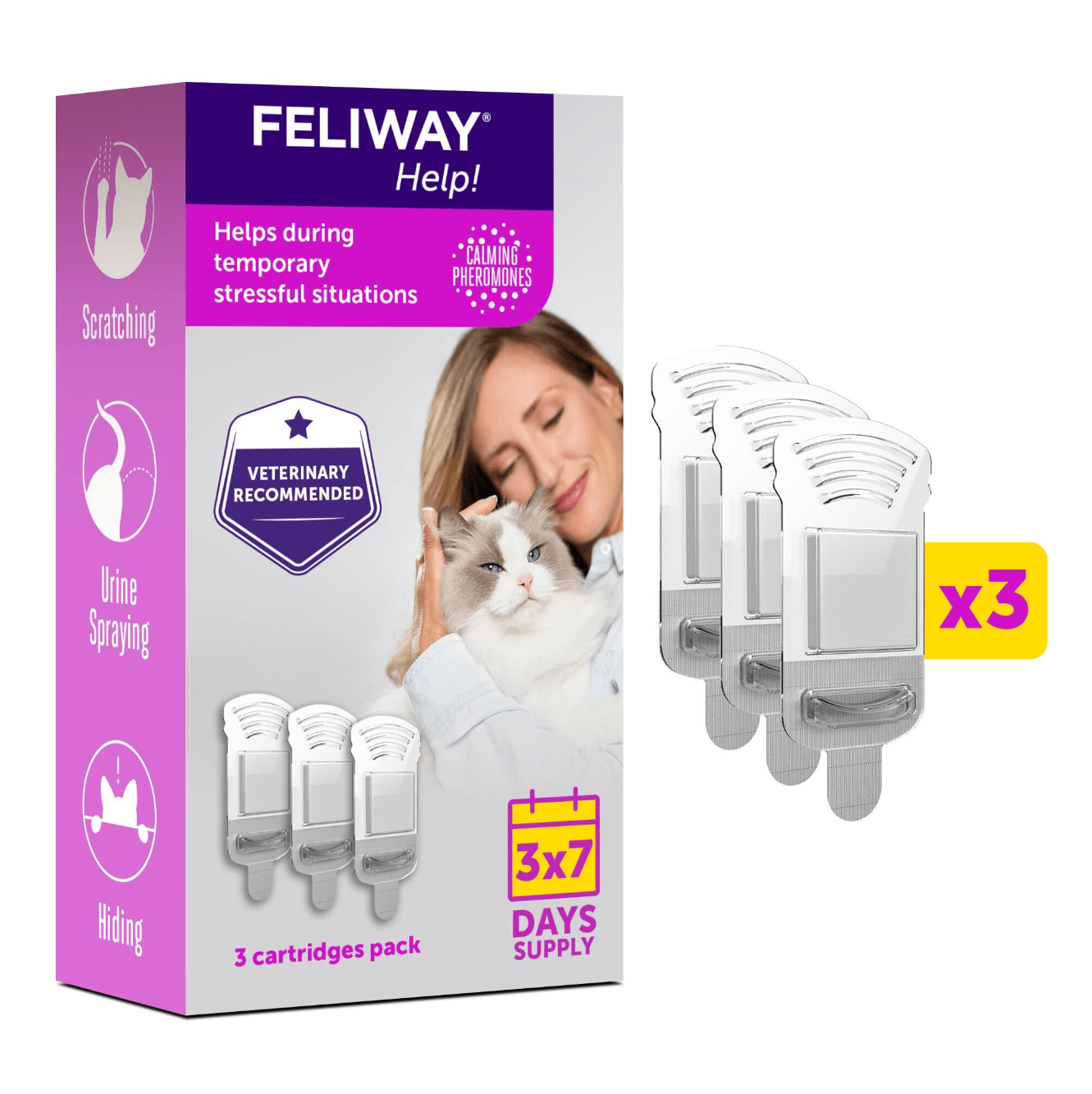
Why Is My Cat Peeing On The Carpet?
Instinctively, cats are clean creatures; you will find they spend up to 50% of their time grooming to make sure their coat is in tip-top condition! They are also very particular about their daily routine, their territory and their toilet facilities.
Generally, cats urinate around 3-5 times a day. You may notice them squatting in their litter tray, followed by a bit of digging and burying. This is how you can distinguish between urinating and spraying!
With this in mind, if your cat has started peeing on your carpet or anywhere else outside their litter tray, it can be frustrating - and concerning! This is known as 'inappropriate urination' and is not uncommon. But when it occurs, it is always important to work out the reason for this change in habit, and take measures to help your pet.
Why is my Cat Peeing on the Carpet?
As well as urinating on carpets, inappropriate urination may happen on any soft item, such as a cushion or even on your bed. These are all soft items which absorb urine nicely so your cat doesn't need to cover it up!
There are a number of reasons why a cat may change its peeing habits:
Underlying medical conditions
If there is any change in your cat's toilet behaviour, their health should always be the first thing you look at, and is the most important thing to rule out. Some common medical issues that could be causing your cat to urinate more than usual include bladder problems, kidney disease, or diabetes.
If the litter tray is getting too soiled, they may be urinating outside the tray, or they may be finding it difficult to get to the tray before they pee. If there has been a change in their toilet habits (and especially if your cat is not peeing at all) always get them checked by a vet straightaway.
Is there a new cat in the house?
If your cat's peeing habits have changed and you've recently introduced a new cat, your resident cat may be feeling stressed or uncertain about how this new addition will affect their daily routine. They may be marking their territory by spraying urine outside their litter tray. Luckily there are lots of ways to encourage a friendly kitty relationships and help them make the best introductions.
Marking territory
A cat typically starts marking its territory when it reaches maturity; this is done by 'spraying' which can often be confused with urinating. When a cat marks its territory in this way (visual scratch marks, and scent marks left by their paws are other indicators), it is to let other cats or pets know that this space is part of their area and that 'they are here'. Or, they may be leaving messages for cats of the opposite sex to let them know they are 'available'!
Alternatively, they could be spraying as they are feeling stressed and the urine marks make them feel safer and the areas more familiar.
Resources
Does each cat in your home have their own litter tray? Cat's don't like to share their resources and, particularly, their toilet facilities, so make sure each cat has their own food and water bowls, beds and litter tray and in a separate place.
Changes in the home
Are you moving furniture around? It takes a cat a little while to get their home comforts just right and any packing or moving of furniture may upset them; urinating in different areas of the house is their way of saying "I don't like change!". Make sure that if you are planning any major changes around the home these are done gradually (when possible) so that your cat can get used to them bit by bit. It's also a good idea to provide a safe area for your cat with their resources nearby, so that your kitty can be happy and safe whilst things are being moved around.
They're not happy with their litter tray!
Is the litter tray large enough? You may have bought a litter tray for a kitten, but once your cat is fully grown, make sure it is still large enough. Cats like to have room to move around and 'dig' when they go to the toilet, so make sure their tray is at least 1.5 times the length of your cat, and just a little wider.
If your kitty likes to dig around when they use their litter tray, it's also worth bearing in mind the depth of the litter. For most cats, 3-4cm is an ideal depth to allow them to dig and bury to their heart's content, but every cat is different so be sure to work to your kitty's preference.
Remember; cat's don't like using a litter tray where the substrate has not been changed regularly! Some cats also like to cover up after themselves, so make sure the tray is deep enough to contain the substrate too.
Or perhaps they just do not like the substrate you are using! Often, cats like the substrate they were using as a kitten, so it may be worth finding out what they used previously. If you decide to switch up the litter used, make sure to do so gradually so that your feline friend has a chance to get used to it.
There are numerous different options that you can use for cat litter and it could be trial and error to find the one that your cat finds most comfortable.
'Clumping' substrates:
- Most cats like a non-scented substrate, like clay. Others like fine, sandy versions with a fine consistency.
- Crushed walnut shells are also a good option for clumping substrates. It's natural, renewable, and sustainable.
'Non-clumping substrates:
- Recycled newspaper. Available in either pellet or granules and highly absorbent.
- Wood / sawdust pellets. Counters the smell of urine with pine, but can be harsher on your kitty's paws - especially if your cat is older!
- Coconut husks. Nice and soft on cats' paws and is also a natural, renewable and sustainable option.
Silica gel beads:
- These are relatively new to the market. Absorbs odours well, but can be uncomfortable on sensitive paws.
Location
Is their litter box in the right place? Cats like their toileting to be private, so make sure their litter box is in a discreet place, away from high traffic areas and definitely away from noisy household items, like a washing machine. They don't like an audience and they certainly won't use a litter tray when they are scared by a washing cycle!
Stress and anxiety
There are a number of reasons why your cat may be anxious or feeling stressed and peeing outside their litter box:
- Changes to their environment - if you are moving furniture around, or moving house.
- There's another cat on the block - cats are territorial and don't like intruders.
- Are they in conflict with another cat? Maybe you have another cat in your home and they don't have enough resources to go round.
- Loud noises: unexpected loud noises can scare a cat, particularly fireworks, so make sure they have a quiet place to retreat to if you are expecting a firework party.
- Medical reasons: if your cat is showing signs of illness or injury, get them checked out by your vet.
- You've gone on holiday! Some cats will pee on the carpet when their routine changes and they are missing their owner. You may consider leaving a small item of clothing in their bed to reassure them that everything will be OK.
Ways to help your cat stop peeing on the carpet
- Try to work out if there have been any changes in your home recently that may coincide with your cat peeing on the carpet or anywhere else in the home.
- Do they have enough resources around? Check that they have a comfy bed and different places to hide.
- Keep their food and water bowls accessible and away from other pets.
- Make sure their litter tray is large enough and cleaned regularly.
- Don't use strong scented cleaners - cats have sensitive noses and don't like strong smells.
- Use FELIWAY Classic Spray when the area is clean and dry. Spray once daily on the areas where you don't want your cat spraying. FELIWAY Classic sends 'happy messages' to cats and helps make them feel safe and secure.
- Put a few litter trays around the house but make sure they are in a quiet spot. This will help you find out which spot they prefer.
- If they are peeing close by to their tray, check the cleanliness of the tray and litter being used. Once both the tray and carpet have been cleaned, try moving the tray to the place they peed last, as they may feel safer in this area.
- If your cat is elderly, check they can still access the litter tray - the sides might be too high for them.
- Keep to a routine - and this should include regular play time.
- If you are going to be away for a long period of time, like going on holiday, leave an item of your clothing in their bed; your scent will reassure them that you will be back soon.
- Do not punish them for peeing on the carpet - this will make them anxious and could make the problem worse.
Once you have worked out why your cat is peeing on your carpet, and taken the necessary actions, you can promote continuous harmony for your cat by using FELIWAY Optimum.
FELIWAY Optimum is a new pheromone discovery that helps cats more with signs of stress, in more situations, and can be used at the same time as FELIWAY Classic Spray.






































